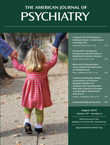The Difficulty of Making a Sole Diagnosis of Antisocial Personality Disorder
To the Editor: Several actions and recommendations made by Daniel Antonius, Ph.D., et al. (1) in their Clinical Case Conference, published in the March 2010 issue of the Journal, are laudable. Much of the case conference was focused on assessing and treating assaultive behavior in patients with antisocial personality disorder comorbid with an axis I major mental illness. The authors' assertion that "Mr. J" had a major mental illness, however, appears to be erroneous. They stated, "In the case of Mr. J, the presence of an axis I diagnosis of mental illness is relatively obvious (1, p. 255). This statement was confusing in light of the lack of substantiation for an axis I disorder in the clinical vignette. The symptoms Dr. Antonius et al. cited for an axis I disorder were self-injurious behavior, mood lability, "hopelessness about the future, and reported insomnia due to nightmares, which [the patient] attributed to a previously undisclosed sexual assault that occurred during a past incarceration" (1, p. 254). The patient was given the axis I diagnosis of mood disorder not otherwise specified in addition to antisocial personality disorder. However, DSM-IV-TR criteria for antisocial personality disorder include impulsivity, irritability, and disregard for the safety of self or others, which would explain the mood lability and self-injurious behavior (2). It is unclear why an additional diagnosis of mood disorder not otherwise specified was made.
The authors appear to have been basing much of their diagnosis of an axis I disorder on the isolated symptoms of mood lability, self-injurious behavior (including suicide attempts), and hopelessness. To the extent that hopelessness may be related to a depressive affect, it has been shown in certain samples of youth with antisocial behavior that gang involvement is associated with negative affect but not major depressive disorder (3). The patient's history of suicidal behavior is consistent with studies that have shown an increased rate of suicidal behavior in individuals with antisocial personality disorder comorbid with substance abuse, and Mr. J had a history of cannabis and alcohol abuse (4). This leaves "insomnia due to nightmares," an isolated posttraumatic stress disorder symptom, as the only symptom not accounted for by antisocial personality disorder. This isolated symptom, however, would not qualify for an axis I psychiatric disorder, including anxiety disorder not otherwise specified, because of the lack of "prominent anxiety or phobic avoidance" that is a requirement for the diagnosis. (2).
With the increased number of forensic psychiatric hospital admissions over the past several years, it is important that psychiatrists make accurate diagnoses in this population. Although quite difficult, being able to make the diagnosis of antisocial personality disorder in the absence of comorbid mental illness and then making an appropriate disposition that does not include psychiatric hospitalization is crucial in preventing the victimization of those with severe mental illnesses.
1 : Psychiatric assessment of aggressive patients: a violent attack on a resident. Am J Psychiatry 2010; 167:253–259 Link, Google Scholar
2 American Psychiatric Association: Diagnostic and Statistical Manual of Mental Disorders, 4th ed, Text Revision (DSM-IV-TR). Washington, DC, American Psychiatric Publishing, 2000 Google Scholar
3 : Influence of gang membership on negative affect, substance use, and antisocial behavior among homeless African-American male youths. Am J Mens Health 2008; 2:229–243 Crossref, Medline, Google Scholar
4 : Assessing suicidal youth with antisocial, borderline, or narcissistic personality disorder. Can J Psychiatry 2003; 48:301–310 Crossref, Medline, Google Scholar



